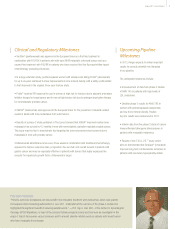Amgen 2011 Annual Report Download - page 19
Download and view the complete annual report
Please find page 19 of the 2011 Amgen annual report below. You can navigate through the pages in the report by either clicking on the pages listed below, or by using the keyword search tool below to find specific information within the annual report.Motesanib
• We along with our partner Takeda Pharmaceutical Company Limited (Takeda) announced that the
motesanib pivotal phase 3 trial (MONET1) did not meet its primary objective of demonstrating an
improvement in overall survival in patients with advanced non-squamous non small cell lung cancer
(NSCLC).
Business combinations
• On March 4, 2011, we acquired BioVex Group, Inc. (BioVex), a privately held biotechnology company
developing treatments for cancers and for the prevention of infectious disease, including talimogene
laherparepvec (formerly referred to as OncoVEXGM-CSF), a novel oncolytic vaccine in phase 3 clinical
development for the treatment of malignant melanoma.
• On April 7, 2011, we acquired Laboratório Químico Farmacêutico Bérgamo Ltda (Bergamo), a privately
held Brazilian pharmaceutical company that is a leading supplier of medicines to the hospital sector in
Brazil with capabilities in oncology medicines.
• On January 26, 2012, we announced that we entered into an agreement to acquire Micromet, Inc.
(Micromet), a publicly held biotechnology company focused on the discovery, development and
commercialization of innovative antibody-based therapies for the treatment of cancer. The acquisition,
which is subject to customary closing conditions, is expected to close in the first quarter of 2012.
Return of capital to shareholders
• In the third quarter of 2011, we began paying quarterly cash dividends of $0.28 per share of common
stock, aggregating $500 million paid in 2011. In December 2011, we increased our quarterly declared
dividend by 29% to $0.36 per share of common stock, payable in March 2012.
• During 2011, we repurchased approximately 15% of our stock outstanding as of December 31, 2010, for a
total cost of $8.3 billion.
Proposed legal settlement
• We recorded a $780 million charge (the legal settlement charge) in connection with an agreement in
principle to settle allegations relating to our sales and marketing practices.
Marketed Products
We market our principal products, Neulasta®, NEUPOGEN®, ENBREL, Aranesp®and EPOGEN®,in
supportive cancer care, inflammation and nephrology. Certain of our marketed products face, and our product
candidates, if approved, are also expected to face, substantial competition, including from products marketed by
large pharmaceutical corporations, which may have greater clinical, research, regulatory, manufacturing,
marketing, financial and human resources than we do. Our products’ competitive position among other biological
and pharmaceutical products may be based on, among other things, safety, efficacy, reliability, availability,
patient convenience/delivery devices, price, reimbursement and patent position and expirations.
Over the next several years, many of the existing patents on our principal products will expire, and we
expect to face increasing competition thereafter, including from biosimilar products. A “biosimilar” product is a
follow-on version of another biological product for which marketing approval is sought or has been obtained
based on a demonstration that it is “biosimilar” to the original reference product. This demonstration will
typically consist of comparative analytical, preclinical and clinical data from the biosimilar product to show that
it has similar safety and efficacy as the reference product. The 2010 U.S. healthcare reform legislation authorized
the FDA to approve biosimilar products under a new, abbreviated pathway. On February 9, 2012, the FDA
released three draft guidance documents that provide insight into the FDA’s current thinking on the development
of biosimilar products and broad parameters for the scientific assessment of biosimilar applications. The FDA
guidance documents leave room for the FDA to consider, on a case-by-case basis, the specifics of what evidence
would be required for a biosimilar product to gain approval (see Government Regulation). In the European Union
3
























